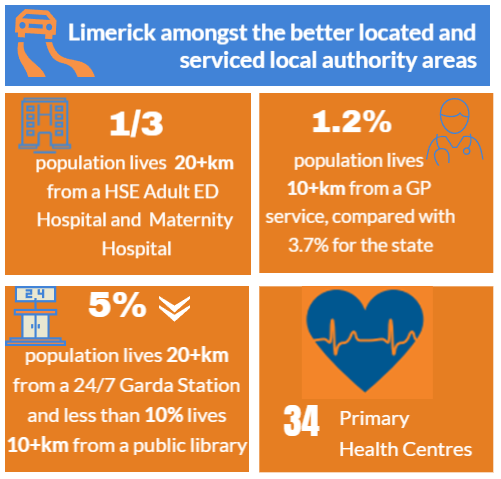2.24 Local Services & Distance to Everyday Services
CSO, in 2022, issued data related to the average distance from dwellings to everyday services which includes analysis of the average situation by urban and rural areas and by county, across the state.[1] This covered a range of private services (supermarket, convenience shop, pharmacy, bank), GP, Post Office, schools, public services including HSE adult emergency department and HSE maternity hospital, library, garda station, fire station as well as the primary and secondary road transport network, train station and bus stop, outdoor sports facility and swimming pool.
Accessibility of Everyday Services: Limerick
The findings showed that most everyday services were within 10km distance at the level of state (all areas) with the exception of a HSE maternity hospital (average distance 22km), a HSE adult emergency department (average distance 20 km) and a train station (average distance 8 km). A Primary School was the service with the shortest average distance to dwelling place (1.5km), followed by outdoor sports facility (1.7 km), supermarket / convenience shop (2.3 km) and Post Office (2.5 km).
There are significant differences between urban and rural areas, with urban areas having much shorter average distance to all services. Services which show the largest differences between urban and rural areas are: train station (21 km average further distance for rural compared with urban), HSE adult emergency department hospital (+20km further for rural areas), a HSE maternity hospital (+19.6 km further for rural) and a garda station open 24/7 (+11.2 km further for rural). A primary school is the service where there is the least difference between urban and rural areas (+1.5km further in rural).
In relation to average distances by county, Limerick is amongst the counties where the average distance to everyday services is shorter than the state averages. Average distance to a HSE Adult Emergency Department hospital and HSE Maternity Hospital is 16.9km, a 24/7 garda station 7.5km, a supermarket / shop 2.1km, a Post Office 2.4km and a library 4.1km.

If access to HSE hospital services based on the percentage of the population living in dwellings that are more than 20km from a HSE Adult Emergency Hospital Department or a HSE Maternity Hospital is considered, Limerick is also amongst the better counties - just over one-third of the population of Limerick is living more than 20km from such services. Only 1.2% of the population is 10km or more from a GP service (compared with 3.7% of the state as a whole) and 20% is 5km or more from a GP service. In terms of other services, Limerick is amongst the best served local authority areas in terms of the percentage of the population living 20km or more from a 24/7 Garda Station (3.9%) and living 10km or more from a public library branch (less than 10%).
Access to Public Transport and National Road Network: Limerick
Focusing on the extent to which local authority areas are well-serviced by public transport, Limerick is amongst the better serviced counties (but not amongst the best, which are all highly urbanised local authority areas). Average distance of dwellings from a bus stop is 2km and to a national primary or secondary road network 4.2km.
Thirty-five percent (35.2%) of the population of Limerick City and County is serviced by less than 10 departures at their closest public transport stop. In relation to distance of the population to national primary and secondary road network, Limerick is amongst the best served counties. Just under 25% of the population (24.5%) are over 5km distance from the national road network.
It should be noted that distance from services is not the same as access to services. There can be many barriers to access – awareness and information, referral process and waiting times, physical mobility issues, trust in services etc.
[1] CSO Measuring Distance to Everyday Services in Ireland. https://www.cso.ie/en/statistics/othercsopublications/measuringdistancetoeverydayservicesinireland/